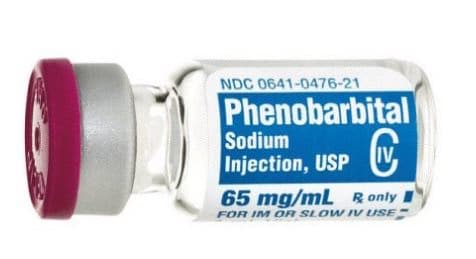At the beginning of my medical training, I grew accustomed to benzodiazepines like lorazepam, chlordiazepoxide, and diazepam as the cornerstone of therapy for alcohol withdrawal based on symptoms and the Clinical Institute Withdrawal Assessment of Alcohol (CIWA) protocol. During my ICU fellowship, I transitioned over to using phenobarbital – a barbiturate with sedative and anticonvulsant properties that depresses cortical activities also to achieve hypnosis. Furthermore, the literature (and pharmacology) suggest less paradoxical reactions with barbiturates compared to benzodiazepines. Moreover, barbiturates stimulate GABA (inhibition) while driving down glutaminergic (excitatory) activity. Win-win! 🙂
In patients with severe alcohol withdrawal histories (e.g., withdrawal seizures, delirium tremens, prior ICU admissions for detoxification, benzodiazepine resistance/paradoxical reactions), phenobarbital therapy may be especially advantageous! However, if patients have a history of previous Stevens-Johnson syndrome or toxic epidermal necrolysis (SJS/TEN) or acute intermittent porphyria (AIP), I tend to be wary.
So how does this work?
First, I try to stratify the risk for respiratory depression based on concomitant benzodiazepines/opioids, pulmonary reserve, age, etc. Then I’ll load phenobarbital over 30 minutes based on ideal body weight: 12-15 mg/kg for low risk, 8-12 mg/kg for medium risk, and 5-8 mg/kg for high risk. If the patient has active withdrawal symptoms or current alcohol use, I’ll usually opt for a higher loading dose.
If active signs of withdrawal persist after the loading infusion (tremor, sweating, delirium, etc.), I’ll consider intravenous administration anywhere from 130 – 260 mg every 30-60 minutes as needed.
Once patients have stabilized and moved to a step-down or general medical-surgical floor bed, they can get oral phenobarbital (100-200 mg every hour) depending on the severity of their symptoms.
An important caveat is that other respiratory depressants should be used with extreme caution! Furthermore, other etiologies of delirium must be considered throughout the hospitalization if patients seem to remain refractory to therapy (e.g., stroke, electrolyte abnormalities, polypharmacy, pain, sepsis, etc.)
Drop me a comment below with questions! 🙂







Hi Dr. Rishi,
I had a patient who was severely withdrawing. I have prior ICU experience and love phenobarbital over benzos, but where I work now “general medical unit”, they are not comfortable with giving high doses of phenobarbital. At your area of practice is there a max dose of phenobarbital that can be given on the floor versus the ICU? For reference my pt received 1430 in 48 hours whereas the guy received 50+mg of Ativan in 48 hours (I know…feel free to cringe). On the day I had this pt ICU didn’t think he needed to go to the unit, but the floor charge nurse was very adamant that as a floor unit we could not give any more phenobarbital….any thoughts about this scenario?
Hey Destiny! The particular heart and vascular institute where my OR and ICU practices are don’t have any floor beds (just ICU and IMU), so I’m not sure what would even be considered “acceptable.” I think in general, most healthcare workers have MUCH more experience with benzos (midazolam, lorazepam, etc.) than barbiturates which drives a lot of practices/rules. In my mind, a patient requiring Ativan so frequently would benefit great from a phenobarbital protocol – less peaks and troughs, kinder for the floor nurses, etc.
Hello sir, in which conditions then disulfiram can be used
I’ve only heard of it being used second or third line outpatient agent for alcohol dependence.
Good point! What about a concomitant epatic insufficiency for chronic alcool abuse?
Great point! Just like all things, I’d prioritize the more life-threatening issues first. Acute withdrawal (especially delirium tremens) has an independent morbidity/mortality associated with it. Gotta get that under control first!
We do hundreds of alcohol detoxifications a year and our standard medication is oral clomethiazole (syrup for easy dose adjustments or capsules) combined with levetiracetam as anticonvulsant prophylaxis. Only in severe casis we add on a benzo (oral lorazepam or i.v. midazolam) and/or clonidine. This usually works wonders. Don’t forget the Vit B1.
Ah that’s awesome! So many ways to do things in medicine. 🙂
As an RN in a rough and tough small town ICU, I often get individuals in alcohol withdrawal, especially ones who have had seizures before…this has never been ordered and I have never heard of it before but will recommend going forward. Thank you for this caveat of knowledge!
Definitely worth looking into! Thanks for reading!
Completely agree! I always encourage my attendings to consider phenobarb over benzos. There is, now, plentiful literature available, and anecdotally, I’ve seen it work wonders at the bedside (not to mention it significantly reduces the nursing burden ?).
Right on! Thanks for the comment!